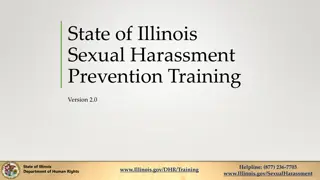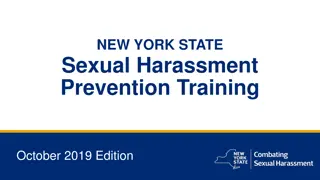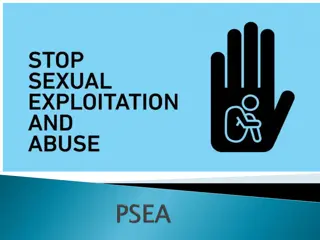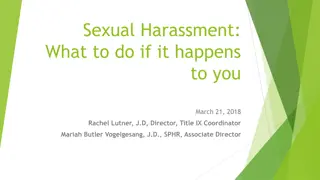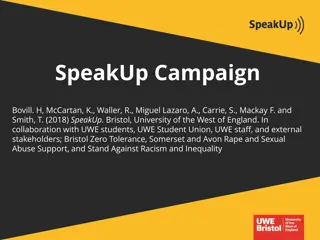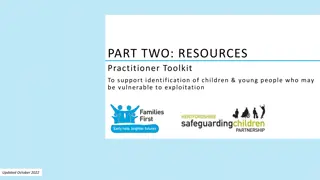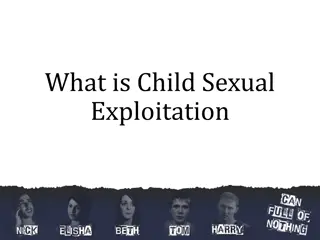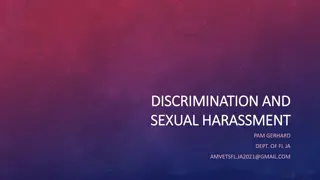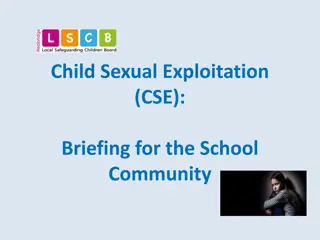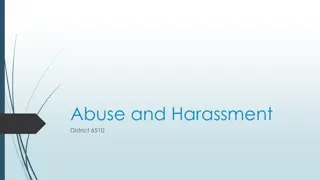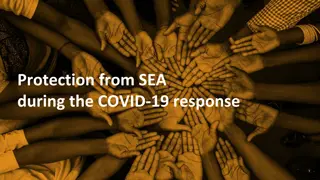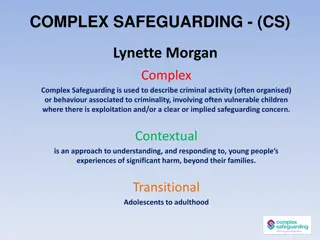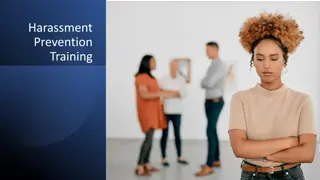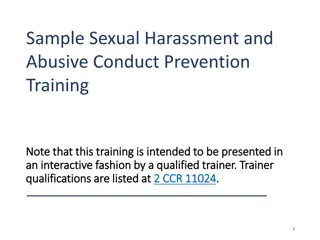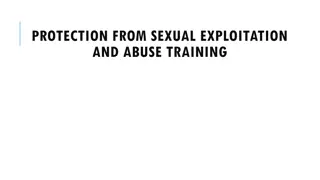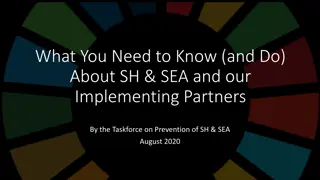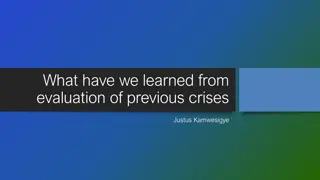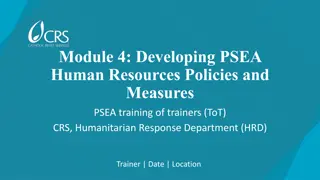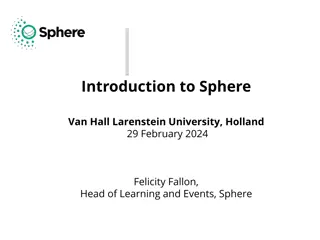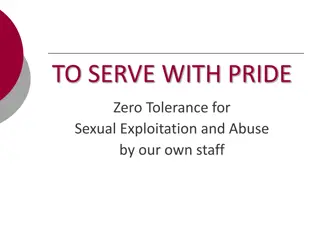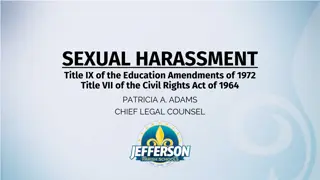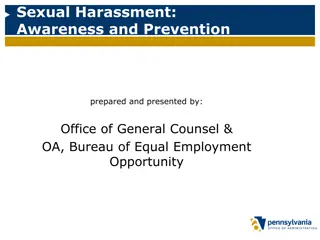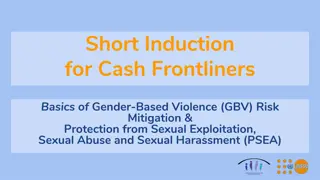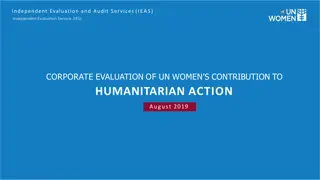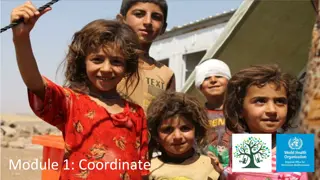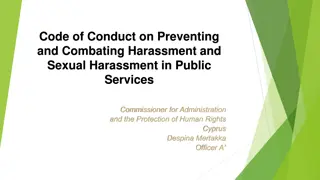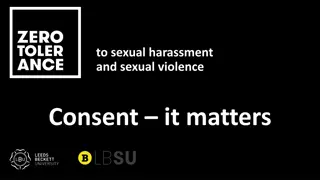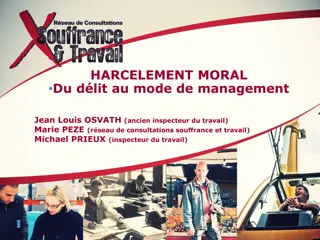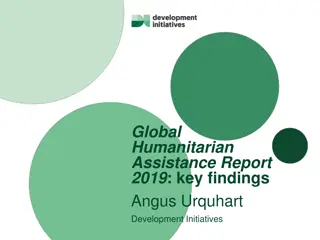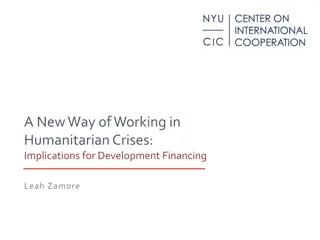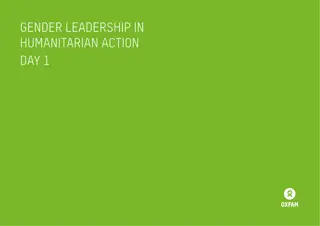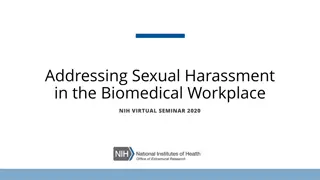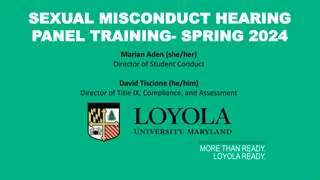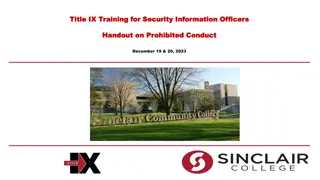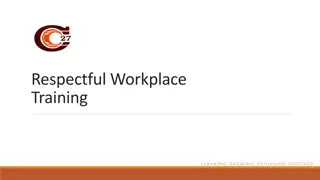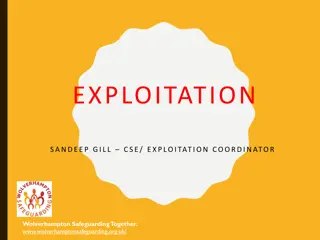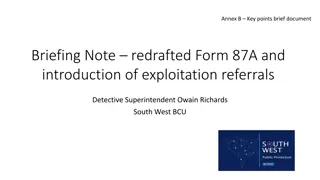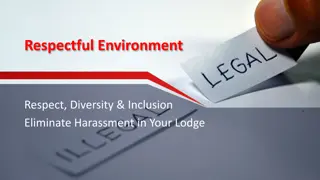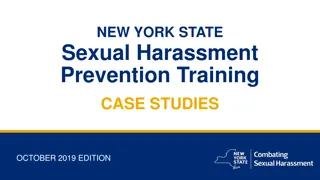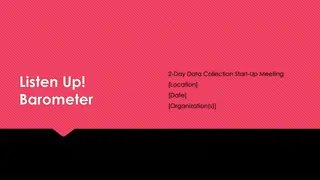Addressing Sexual Harassment and Exploitation in Humanitarian Work
Discussing a case study where a female teacher, Haleema, faces sexual advances from a male staff member, Ahmad, in a humanitarian project in Balochistan. Exploring the definitions of sexual harassment and exploitation, analyzing the power dynamics between the individuals involved, and considering the impact of such behavior on Haleema.
Download Presentation

Please find below an Image/Link to download the presentation.
The content on the website is provided AS IS for your information and personal use only. It may not be sold, licensed, or shared on other websites without obtaining consent from the author. Download presentation by click this link. If you encounter any issues during the download, it is possible that the publisher has removed the file from their server.
E N D
Presentation Transcript
Protection from Protection from Sexual Harassment, Exploitation and Abuse Sexual Harassment, Exploitation and Abuse NATIONAL HUMANITARIAN NETWORK
Case Study ABC Project is providing education services in remote areas of Balochistan. There are many local facilitators/teachers / mentors hired in the project. Women are paid at the end of each week/month, depending on their performance. ABC field staff is present in the field to supervise as well as to make the payments. Ahmad is one such staff. He is notorious for eyeing female teachers/ facilitators with sexual interest. He makes passes at them while they are working, trying to get close to them and touch them. Female teachers are scared to say anything lest he cuts off the number of days and/or may finish their contract. So they try to avoid him in subtle ways. Ahmad shows particular interest in Haleema who is shy and does not mix around much with the other Teachers/staff members. She is a young widow with two children. Ahmad approaches Haleema on the pretext of supervising her children and has expressed concern for their future. Haleema keeps quiet and wishes him away each time he makes advances towards her. Ahmad often shows leniency to Haleema in terms of giving extra time to rest and feed her child, letting her off sooner than others and so on. This has created much resentment amongst the other teachers / facilitators and alienated Haleema further from the group.
Discuss Do you think Ahmad s behavior can be termed as sexual harassment or exploitation? Why? Would it be termed sexual exploitation if Haleema submits to Ahmad s advances? Why doesn t Haleema complain? Should Haleema be blamed for keeping quiet? Are Haleema and Ahmad at par with each other/equally powerful in the given situation? Who can she complain to? What is the likely impact of Ahmad s behavior on Haleema? How did you feel enacting your respective characters?
Definitions Sexual harassment Any unwelcome sexual advance, comment, expressed or implied sexual demand, touch, joke, gesture, or any other communication or conduct of a sexual nature, whether verbal, written or visual, by any person to another individual within the scope of organization work. The definition includes sexual harassment that is directed at members of the same or opposite sex and includes harassment based on sexual orientation.
Sexual exploitation pressuring or demanding individuals to provide sexual favors against their will, with the threat of denying project assistance, withholding work support, or any other negative repercussions in the work place or community. Sexual abuse any actual or threatened physical intrusion of a sexual nature, by force or under unequal or coercive conditions.
Gender-based Violence Gender-Based violence refers to harmful acts directed at an individual based on their gender. It is rooted in gender inequality, the abuse of power and harmful norms. Gender-based violence (GBV) is a serious violation of human rights and a life-threatening health and protection issue.
Examples of Sexual Harassment, Sexual Exploitation and Sexual Abuse Examples of Sexual Harassment, Sexual Exploitation and Sexual Abuse Offering special benefits (including money, employment, goods or services) to program participants in exchange for expressed, implied or demanded sexual favors; Threats or insinuations that an individual s refusal or unwillingness to submit to sexual advances or demands will affect the person s entitlement to project assistance & support; Verbal conduct such as sexually derogatory remarks, graphic verbal commentaries about an individual s body or dress, sexually degrading words used to describe an individual, sexually suggestive or obscene letters, notes, emails or invitations, demeaning or inappropriate comments, name-calling, jokes,or sexual advances; Visual conduct such as staring, sexual gestures, displaying or distributing sexually suggestive objects or pictures, cartoons or magazines; Actual or threatened physical contact or conduct, such as patting, pinching, blocking movements, or any other offensive touching; Expressing sexual interest or engaging in any sexual activities with children (any person below the age of 18)
IMPACT OF SEXUAL HARASSMENT, SEXUAL EXPLOITATION AND SEXUAL ABUSE Psychological Guilt, stress, Anger, Shame, Anxiety, powerlessness, low self image Physical Headache, Nausea, insomnia, high BP, STDs/ STIs, HIV/AIDs Social Social alienation due to loss of reputation, increased vulnerability
Obstacles Faced in reporting Fear of losing assistance Fear of being disbelieved/blamed Loss of reputation of self and/or family Mistrust /lack of confidence in the system Lack of information about the complaints mechanisms Cultural norms and practices Acceptance of behavior by minimizing or denying its impact Fear of backlash on their family members. Lack of information about the existing mechanisms to respond to such complaints. Absence of family/ lack of support from family. Limited or no economic opportunities Inherent hierarchy between staff and clients
Preventing SEAH in our Context Group 1: Office Group 2: Community Group 3: Centers Questions to Answer: What makes children / women and other vulnerable groups, vulnerable to sexual exploitation and abuse? Who will prevent it? How do we monitor? What actions we may need to take, when and by whom?
Be aware of Organizational Policies / country law Code of Conduct Dos and Don'ts Reporting channels Violation of Code of Conduct shall be treated as serious misconduct and shall lead to strict appropriate disciplinary measures as per the established procedures.
Individual Actions to Respond to Incidents of Sexual Harassment, Exploitation and Abuse Individual Actions to Respond to Incidents of Sexual Harassment, Exploitation and Abuse Upon disclosure, take the person into confidence and listen patiently in a non- judgmental manner. Report immediately using the reporting channels while explaining the procedure to the complainant. Support and assist the person in receiving referral services such as psychosocial, legal and medical appropriate in a given situation. Confidentiality - Do not indulge in any loose talk, spread rumors or divulge any information related to the incident to anyone other than the concerned authority.
Making a Complaint, Referral and Investigation Mandatory Reporting Complaints can be made by or on behalf of a survivor by filling out the Complaints Form. Submit the complaints to the reporting channel Next Steps: For Survivor Assistance: Case is immediately referred to the Case management service providers for follow-up. Refers complaint to the investigation unit within 24-36 hours and to concerned designated focal point DSPs conducts an investigation according to its internal procedures PSEA Committee is convened if the complaint does not have sufficient evidence to refer the case.
Individual Responsibility to Prevent Sexual Harassment, Exploitation and Abuse Individual Responsibility to Prevent Sexual Harassment, Exploitation and Abuse Build awareness about various aspects of Sexual Harassment, Exploitation and Abuse - forms, nature, causes and its impact and educate yourself on how to deal with it appropriately and adequately. Be aware of Organization policies / National Laws and code of conduct on preventing and responding to Sexual Harassment, Exploitation and Abuse, applicable to your country context. Create and use opportunities to discuss the issue of Sexual Harassment, Exploitation and Abuse and dispel myths attached to it at an informal level. Exhibit professionalism in your manner of conduct and act in accordance to this Code of Conduct.
Child refugee sex scandal Child refugee sex scandal Tuesday, 26 February, 2002, 22.33 GMT The United Nations High Commissioner refugee camps in west Africa following the revelation that large numbers of children have been sexually exploited by aid workers there. for Refugees has sent a team of investigators into The scale of the problem - revealed in an overview of a report by the UNHCR in conjunction with the British- based charity Save the Children - has surprised relief personnel
Milestones in addressing SEA Milestones in addressing SEA 2001/2 West Africa SEA scandal March 2002 Formation of IASC Task Force on Protection from Sexual Exploitation and Abuse in Humanitarian Crises October 2003 SG s Bulletin on Protection from SEA (ST.SGB/2003/13) March 2004 IASC Model Complaints and Investigations Procedures 2005 The ECHA/ECPS NGO Task Force on PSEA replaced IASC Task Force UN declared a zero-tolerance policy Building Safer Organizations guide
The U.N. Sex Scandal The U.N. Sex Scandal From the January 3 / January 10, 2005 issue: Exploitation, abuse, and other humanitarian efforts. LAST MONTH A CLASSIFIED UNITED Nations report prompted Secretary General Kofi Annan to admit that U.N. peacekeepers and staff have sexually abused or exploited war refugees in the Democratic Republic of Congo. The worst of the 150 or so allegations of misconduct--some of them captured on videotape--include pedophilia, rape, and prostitution. While a U.N. investigation into the scandal continues, the organization has just suspended two more peacekeepers in neighboring Burundi over similar charges. The revelations come three years after another U.N. report found "widespread" evidence of sexual abuse of West African refugees.
Milestones in addressing SEA Milestones in addressing SEA (cont d) (cont d) 2005 Prince Zeid report: DPKO Conduct & Discipline Units Deployed 2006 InterAction, SEA sub-working group launched Statement of Commitment Eliminating SEA by UN & non-UN personnel High-level conference on eliminating SEA by UN and NGO personnel 2007 UN film To Serve with Pride Victim Assistance Strategy 2008 Technical PSEA Meeting development of the Four Pillars Framework 2010 PSEA Global Review [IASC mandated] Website on PSEA: www.un.org/pseataskforce/ Formation of IASC PSEA Taskforce (NGO co-chair) ;now, www.pseataskforce.org 2012 IOM Director, Amb.Bill Swing leads senior managers outreach
Key Milestone: Key Milestone: UN Secretary UN Secretary- -General s Bulletin (2003) General s Bulletin (2003) UN Secretary-General s Bulletin (SGB) Applies to all staff, partners, contractors, peacekeepers Applies 24/7 and in all places Defines Sexual Exploitation and Sexual Abuse
IASCs Six Core Principles 1. Sexual exploitation and sexual abuse constitute acts of serious misconduct and are therefore grounds for disciplinary measures, including summary dismissal. 2. Sexual activity with children (persons under the age of 18) is prohibited regardless of the age of majority or age of consent locally. Mistaken belief in the age of a child is not a defence. 3. Exchange of money, employment, goods or services for sex, including sexual favours or other forms of humiliating, degrading or exploitative behaviour, is prohibited. This includes any exchange of assistance that is due to beneficiaries of assistance. 4. Sexual relationships between United Nations staff and beneficiaries of assistance, since they are based on inherently unequal power dynamics are strongly discouraged. 5. Where a [United Nations] staff member develops concerns or suspicions regarding sexual exploitation or sexual abuse by a fellow worker, whether in the same agency or not and whether or not within the United Nations system, he or she must report such concerns via established reporting mechanisms. 6. [United Nations] staff are obliged to create and maintain an environment that prevents sexual exploitation and sexual abuse. Managers at all levels have a particular responsibility to support and develop systems that maintain this environment .
Exercise Review your organization s Code of Conduct: Are all 6 core principles included? Is yours stronger or weaker than the SGB? What do you think of your Code of Conduct in comparison to the SGB?
Day 2 FRAMEWORK: COMMUNITY ENGAGEMENT, PREVENTION, RESPONSE, MANAGEMEN FRAMEWORK: COMMUNITY ENGAGEMENT, PREVENTION, RESPONSE, MANAGEMENT & COORDINATION COORDINATION T & NETWORK & MEMBERS ROLE NETWORK & MEMBERS ROLE SYSTEMS: REPORTING, INVESTIGATIONS & DISCIPLINAREY MEASURES SYSTEMS: REPORTING, INVESTIGATIONS & DISCIPLINAREY MEASURES FOCUS ON PREVENTION FOCUS ON PREVENTION
Day 2 Groups & Tasks Group 1: Framework: Community Engagement, Prevention, Response, Management & Coordination Group 2: Network & Members Role Group 3: Systems: Reporting, Investigations & Disciplinarey Measures Individual: Prevention Action Planning
Minimum Benchmarking for PSEA Policies & Procedures for Organizations
1: Organizational Policy Required: The organization has a policy document on PSEA. At a minimum, this document should include a written undertaking that the partner accepts the standards in ST/SGB/2003/13. (UN IP Protocol para 15 & Annex A.4) Code of Conduct (internal or interagency) PSEA policy Documentation of standard procedures for all personnel to receive/sign PSEA policy Other (please specify):
2: Organizational Management Required: The organization s contracts and partnership agreements include a standard clause requiring sub-contractors, to adopt policies that prohibit SEA and to take measures to prevent and respond to SEA. (UN IP Protocol para 11; 15; & Annex A.1) Contracts/partnership agreements for sub- contractors Other (please specify
3: Human Resources Systems Required: There is a systematic vetting procedure in place for job candidates through proper screening. This must include, at minimum, reference checks for sexual misconduct and a self- declaration by the job candidate requesting that they confirm that they have never been subject to sanctions (disciplinary, administrative or criminal) arising from an investigation in relation to SEA, or left employment pending investigation and refused to cooperate in such an investigation. (UN IP Protocol para 11; 15; & Annex A.2) Reference check template including check for sexual misconduct (including reference from previous employers and self-declaration) Recruitment procedures Other (please specify):
4. Mandatory Training Required: The organization holds mandatory trainings (online or in- person) for all personnel on PSEA and relevant procedures. The training should include: 1) a definition of SEA (that is aligned with the UN's definition); 2) explanation on prohibition of SEA; and 3) actions that personnel are required to take (i.e. prompt reporting of allegations and referral of victims). (UN IP Protocol para 17 & Annex A.5) Annual training plan Training agenda Training package Attendance sheets Training certificates Other (please specify):
5: Reporting Required 1: The organization has mechanisms and procedures for personnel, beneficiaries and communities, including children, to report SEA allegations that comply with core standards for reporting (i.e. safety, confidentiality, transparency, accessibility). (UN IP Protocol para 19 & Annex A.3) Internal Complaints and Feedback Mechanism Participation in joint reporting mechanisms Communication materials PSEA awareness-raising plan Description of reporting mechanism Whistle-blower policy Other (please specify):
6: Assistance and Referrals Required 1: The organization has a system to refer SEA victims to available support services available locally, based on their needs and consent. This can include actively contribution to in-country PSEA networks and/or GBV systems (where applicable) and/or referral pathways at an inter-agency level. (UN IP Protocol para 22.d.) Internal or Interagency referral pathway List of Available service providers Description of referral or Standard Operation Procedure (SOP) Referral form for survivors of GBV/SEA Guidelines on victim assistance and/or training on GBV and GBV case management principles Other (please specify):
7: Investigations Required: The organization has a process for investigation of allegations of SEA and can provide evidence. This may include a referral system for investigations where in house capacity does not exist. (UN IP Protocol para 20, 23 and 24, & Annex A.6) Written process for review of SEA allegations Dedicated resources for investigation(s) and/or commitment of partner for support PSEA investigation policy/procedures Contract with professional investigative service Other (please specify):
8: Corrective Action Required: The organisation has taken appropriate corrective action in response to SEA allegations, if any. (UN IP Protocol para 20, 22.a., & Annex A.6) Evidence of implementation of corrective measures identified by the UN partner entity, including capacity strengthening of staff. Specific measures to identify and reduce risks of SEA in programme delivery. Other (please specify):
Provincial Targets for Action Planning Targets Province Community Sessions Staff Sessions 6 4 5 3 1 1 FGD Sindh 1 1 1 1 1 10 10 10 10 10 Balochistan KP Punjab AJK ICT
Action Plan Template Activity Responsible Person Timeline Province Venue



